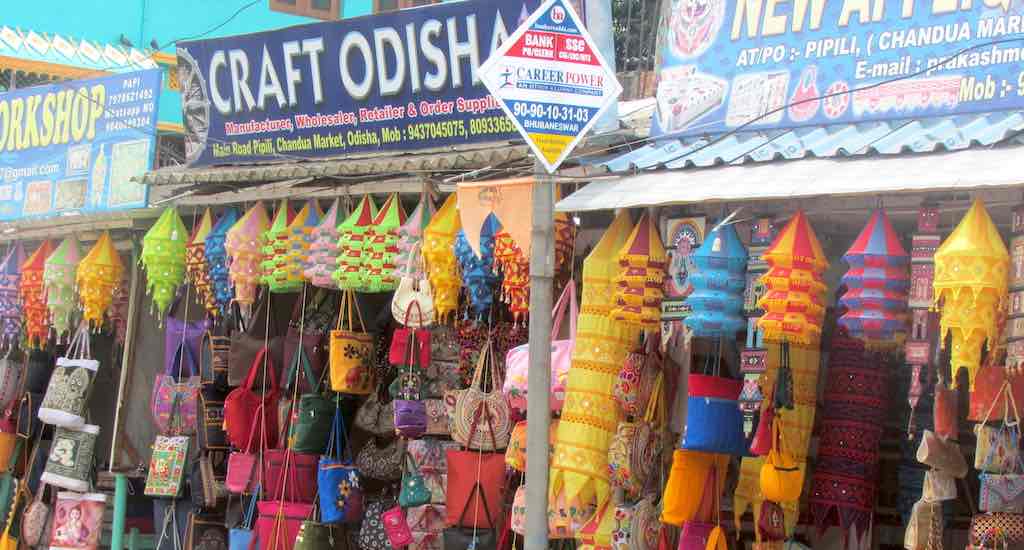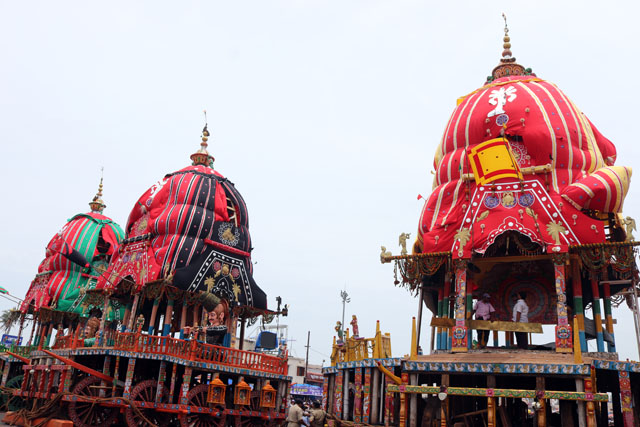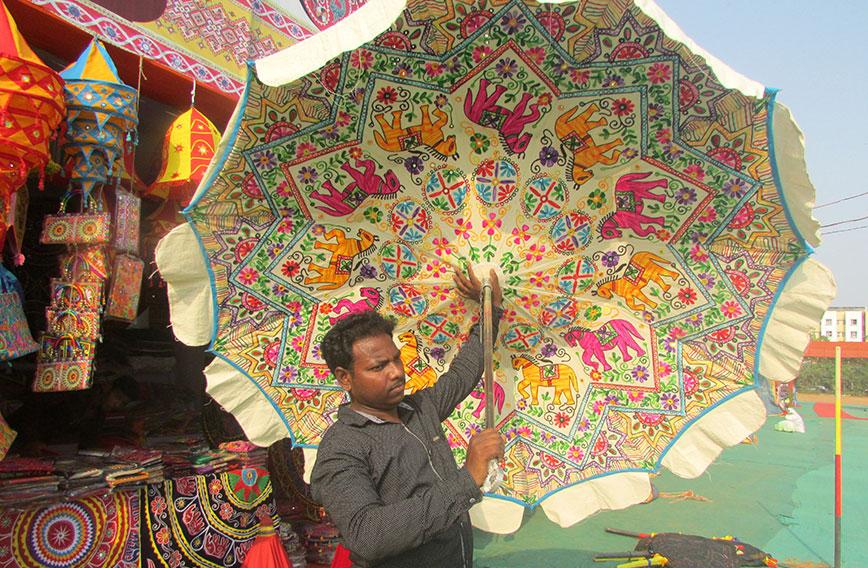Pipili is a small town, situated on the way to Puri, Lord Jagannath temple just before 40 kilometers from Puri, Odisha. The income of this town is essentially dependent on the business of its handicrafts of which especially the applique works are the main source. Nowadays, Pipili is globally known as the destination of applique and is where many workers and workshops continue to practice the technique, creating both traditional and contemporary items.

The French term ‘Applique’ translates to ‘to apply’ and is explanatory of the technique of the age-old craft. Applique in textiles and is the technique of superimposing threads over small pieces of fabric and round mirrors, onto a large base fabric. Pipili is a small town of Jagannath Dham(Puri District, Odisha) where the craft of applique is held in high esteem. The craft of applique is also prominent in the states of Bihar and Rajasthan, but it is originally originated from Pipili and the way craft makers from Pipili can make those craft can’t be made by anyone else or anywhere else other than them.

Origin of Pipili Applique
Pipili Applique work owes its origin to the culture of Lord Jagannath during the 12th century. Earlier applique umbrellas and canopies were prepared by the Gajapatis for the annual Ratha Jatra of Jagannath.
Recent Trends
Artist from other states are now a days following craft makers from Pipili to make these Applique crafts. Also the craft of applique is found to be prominent in the states of Bihar and Rajasthan, but it is originally originated from Pipili and the way craft makers from Pipili can make those craft can’t be made by anyone else or anywhere else other than them. It is one of the products which has been granted Geographical Indication (GI) by the government of India.
The base material used in this craft work in mainly a piece of cloth, which are various types (Water proof material for umbrellas, velvet for tents, cotton, plastic or glass mirrors and threads). On top of that different types of Hindu mythological sculptures, natural figures, animals including elephant, tiger, horse and birds including peacocks, ducks, parrots also flowers such as Sunflower, Jasmine and Marie-golds are being made now a days.

The craft includes embroidering and stitching, attaching multiple small pieces of craft cloths to make a bigger one, the makers use straight stitches, blind stitches or buttonhole stitches to make the crafts look flawless.
The annual Chariot Festival, known as Rath Yatra which get celebrated on every year summer, is famous worldwide and people in millions come to witness this festival at Puri, Odisha. On this festivals Lord Jagannath, Lord Balabhadra and Devi Subhadra comes out of the temple to have a visit for Mausima temple nearby, Where the chariots are bedecked with Pipili applique canopies, known as chanduas.

As millions of pilgrims come to witness this festival, and they know about the Worldwide famous craft (Pipili Applique) they often seen purchasing appliques like banners, lamps, sunflower craft, umbrellas and pouches(batuas) to offer them to Lord Jagannath. However, applique creations adorn the roadsides of Pipili all year round, with tourists flocking to the town to witness the traditions and exquisite productions of the long established textile art.

These days, everytime round the year tourists flock to the town just to get a glimpse and purchase a piece of its colourful applique items. No longer are applique items restricted to the likes of canopies and tents produced as offerings to deities. Time has introduced items such as patachitra, Dokara art, wooden carvings, palm leaf paintings, blouses, purses and modern umbrellas to be enjoyed by all who see the beauty in this hereditary craft.
At first I would like to address that the shopkeepers and shop owners are so humble that they offer every customer a seat and ask for a cold or hot drink. You will see this gesture in almost all the shops. Then finally after attending a lot of customers Mr. Mahapatra finally gave us some time and talked about the challenges they are facing, adaptations they made and earning of a applique maker. He stated his facts as follows:
Mr. Mahapatra Said: He is a applique maker personally from childhood and it has been 45 years, in which he faced many ups and downs but the passion for the craft is what kept him motivated to continue and pass through all hurdles. He said that they have a local society named as ‘Pipili Applique Workers Society’ which is linked with Odisha government. They provide them a applique makers identity card through which they get some subsidiary money to grow their micro productions also this society take care about them during natural disasters too. Giving us an example, he further added that recently before one year on May 2018 during a super cyclone named ‘Fanni’ they got a good amount of relief, personally telling about him he added that he got an relief amount of 30,000 rupees against the waste of some raw material and machineries. Telling about where government is lacking he added that government organising skill development programs for general stitching works and dress materials but not making any sort of arrangements objectively for regional crafts or especially telling about applique works.

He further added the new bypass road built in 2016 because of Nabakalebara of Lord Jagannath is a reason behind their massive loss in business now a days. It’s widely affecting them as many of Tourist are now moving through the new road. Commonly they get a upsurge in sales during Cart festival of Lord Jagannath Temple and Christmas holidays but now a days it’s hampered due to bypass road. He said that government is only promoting Konark Sun temple, Puri Jagannath Temple, Bhubaneswar Lingaraj temple and Dhauligiri in the name of tourism, neither promoting of other tourist places in Odisha nor any regional craft across the state.
We further had a wide discussion with different applique makers about the fact that if they are not making an expected amount of money from their store, have they tried to sale or export outside or not? There we met another person who is a full-time worker and have a own applique shop named Jogendra Seth. He said that almost no one in the locality are making international trades but a few from them have suppliers from other states in India and they export some of there craft to them. But there also they are getting a lot of issue on payment as like rarely they get payment on delivering their items, but most of the time vendor pay them money after 6-8 months later after selling the crafts. Sometimes they don’t even get their principal money even. Due to payment issues very few number of workers are now exporting to outer states.

When we are talking about there earning, he added that before the bypass road inaugurated, they are earning almost 20-25% profit on their investment but now a days it’s decreased to 13-15%, also he told that Goods and service tax implementation after 2017 also caused a measure problem for them. He also told us from an investment of 10 lakhs a shopowner can earn almost 30,000-35,000 rupees after all expenses.
Taking with some of shopkeepers we get a rough idea that now a days customers are not getting satisfied with banners, lamps and umbrellas, so they have added a bit of modern art like bottle paintings, Dokara art, Aluminium foil paintings. Also they told us that now a days they are not selling the ancient patachitra leaves directing, they are framing them with wooden frames to give it a modern look. They are also constantly evolving and now a days if you will have a visit to an applique shop in Pipili applique village then you will find there and thousand variety of products including banners, embroidery saree, dresses, table cloth, garden umbrella, Jewellery box made with korai grass and threads, hundred types of utility purse, which are full with embroidery works, and I would like to tell you that you will find many of these crafts here in www.spenowr.com .
After centuries of practicing and making there techniques better day by day Pipili has an entry in the 2004 Limca Book of Records (which is a type of Indian Guinness Book of Records) for the world's largest thematic applique work. The 54-metre (177 ft) long work is filled with depictions of India's struggle for independence.